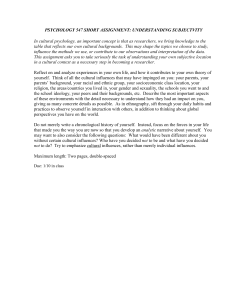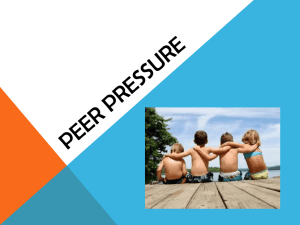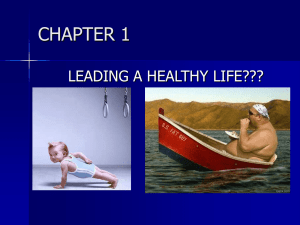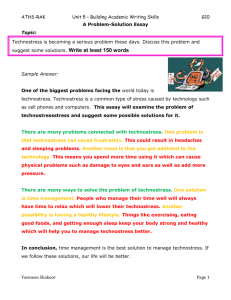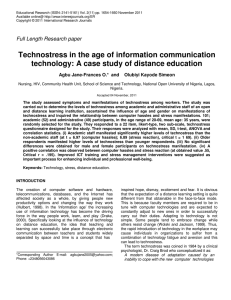CHAPTER 1
advertisement
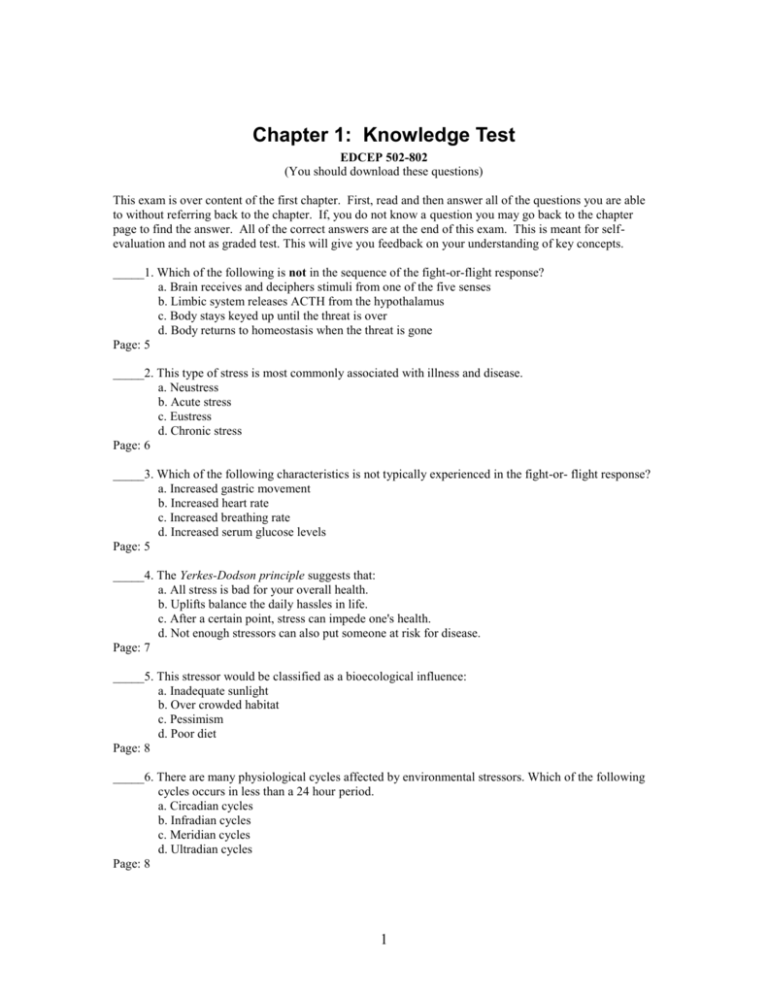
Chapter 1: Knowledge Test EDCEP 502-802 (You should download these questions) This exam is over content of the first chapter. First, read and then answer all of the questions you are able to without referring back to the chapter. If, you do not know a question you may go back to the chapter page to find the answer. All of the correct answers are at the end of this exam. This is meant for selfevaluation and not as graded test. This will give you feedback on your understanding of key concepts. _____1. Which of the following is not in the sequence of the fight-or-flight response? a. Brain receives and deciphers stimuli from one of the five senses b. Limbic system releases ACTH from the hypothalamus c. Body stays keyed up until the threat is over d. Body returns to homeostasis when the threat is gone Page: 5 _____2. This type of stress is most commonly associated with illness and disease. a. Neustress b. Acute stress c. Eustress d. Chronic stress Page: 6 _____3. Which of the following characteristics is not typically experienced in the fight-or- flight response? a. Increased gastric movement b. Increased heart rate c. Increased breathing rate d. Increased serum glucose levels Page: 5 _____4. The Yerkes-Dodson principle suggests that: a. All stress is bad for your overall health. b. Uplifts balance the daily hassles in life. c. After a certain point, stress can impede one's health. d. Not enough stressors can also put someone at risk for disease. Page: 7 _____5. This stressor would be classified as a bioecological influence: a. Inadequate sunlight b. Over crowded habitat c. Pessimism d. Poor diet Page: 8 _____6. There are many physiological cycles affected by environmental stressors. Which of the following cycles occurs in less than a 24 hour period. a. Circadian cycles b. Infradian cycles c. Meridian cycles d. Ultradian cycles Page: 8 1 _____ 7. This stressor would not be classified as a social influence under the Social Readjustment Rating Scale: a. Noisy habitat b. Death of a spouse c. Financial problems d. Vacation retreat Page: 9-10 ______8. College students have their own life changes. These three “events” top the list of most stressful events during the school year. a. death of a family member, death of a friend, and parental divorce b. car troubles, pregnancy, and change of major c. change in sleeping habits, change of major, and roommate problems d. poor grades, financial problems, roommate problems. Page: 11 9. In his stress theory Lazarus says that daily hassles cause stress. Which is a cause of hassles according to Lazarus? a. interactions with idiots b. high paced society c. unmet expectations d. poor emotional control Page: 11-12 _____10 According to research by Holmes and Rahe, a person who scores more than ____ points on the Social Readjustment Rating Scale is quite vulnerable to stress: a. 100 points b. 150 points c. 200 points d. 250 points Page: 9 _____11. Most stressors fall in this category: a. Bioecological influences b. Psychointerpersonal influences c. Social influences d. Socioecological influences Page: 8 _____12. Hans Selye listed this as the first stage of the General Adaptation Syndrome: a. Resistance b. Alarm c. Exhaustion d. Termination Page: 13 _____ 13. The digital divide, information overload and cell phone proliferation can be summed up in one expression: a. 24-7 society b. technostress c. the information age d. Big Brother Page: 15 2 _____ 14. In terms of occupational stress, the Mitchum Report revealed that: a. nine out of ten people say they are stressed at work all the time. b. one out of four people say they are highly stressed at work everyday. c. five out of ten people say they are stressed once a week at work. d. one out of four people wish to quit their jobs due to stress. Page: 18 _____ 15. According to the National Safety Council, _____ work related accidents are the result of human stress. a. 10-20% b. 30-50% c. 60-80% d. 70-90% Page: 18 ______ 16. The holistic wellness paradigm is based on the integration, balance and harmony of these four components: a. mind, body, spirit and environment. b. home, work, play and family. c. mind, body, spirit and emotions. d. Sleep, nutrition, exercise and friends. Page: 21 _____17. Regarding stress management, the wellness paradigm suggests that: a. the whole is greater than the sum of the parts. b. one should address the causes and the symptoms of stress equally. c. one should address the mental, emotional, spiritual, and physical aspects of well-being. d. the Newtonian view of medicine is wrong. Page: 20-21 TRUE/FALSE: Please circle the correct choice, either TRUE or FALSE, in the space provided for each of the following questions. 1. TRUE Page: 4 FALSE. Experts agree that stress can be defined as the “rate of wear and tear on the body." 2. TRUE Page: 5 FALSE. Social influences are the most likely influences to cause stress in one's life. 3. TRUE FALSE. Holmes and Rahe point out that a person who obtains more than 200 LCUs is prone for stress-related illness. Page: 9 4. TRUE FALSE. The dualism of mind and body that has so strongly influenced Western medicine, was conceived and advocated by Isaac Newton. Page: 19 5. TRUE FALSE: Regarding stress and aging, those people who put all their self-esteem in their job tend to have more disease and illness after they retire. Page: 18-19 6. TRUE FALSE: In terms of technostress, the rate of change with technology seems to have outpaced the level of responsibility and moral codes that accompanies it. Page: 15 3 7. TRUE Page: 21 FALSE: The word health really means “to be whole.” 8. TRUE Page: 21 FALSE: By and large, healing and curing mean the same thing. 9. TRUE FALSE: A paradigm shift means adopting Eastern philosophies in the Western culture and society. Page: 19 Answers to the Above Questions: 1-b, 2-d, 3-a, 4-c, 5-a, 6-b, 7-a, 8-a, 9-c, 10-b, 11-b, 12-b, 13-b, 14-b, 15-c, 16-c, 17-c True or False: 1-F, 2-F, 3-F, 4-F, 5-T, 6-T, 7-T, 8-F, 9-F, Definition of Terms: Please define the following term or concept in no more than two sentences and give an example to support your definition: Page # (please see index) A. Acute stress B. Alternative medicine C. Alarm reaction D. Biological influences E. Chronic stress F. Emotional well-being G. Eustress H. Fight or flight response I. General adaptation response J. Homeostasis K. Technostress L. Digital divide M. Occupational stress N. Mental well-being O. Physical well-being P. Emotional well-being Q. Spiritual Well-being R. Social influences S. Wellness paradigm 4 Essay Questions Please answer the following questions in an essay format. Begin with an opening statement, document, and outline your content in a clear succinct manner and end with a concluding statement. 1. From the perspective of wellness, define stress, explain each component of wellness and explain how stress affects each area of the wellness paradigm. Finally, discuss how coping and relaxation techniques can be used to promote optimal wellness. 2. Describe the difference between acute stress and chronic stress. Next, explain the differences between the fight-or-flight response and the general adaptation syndrome. Finally, describe the classifications stressors fall into and include examples of each. 3. Change is often synonymous with stress. According to sociologists, we are living in times of great change. Address the issues of change with regard to the following: 1. Technostress 2. College age stress 3. Occupational Stress 4. Stress and the aging process 5



